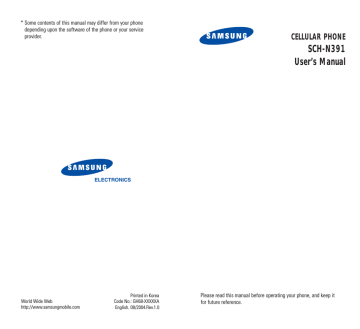advertisement

136
H ea h a nd attiio n
Electronic Devices
Most modern electronic equipment is shielded from radio frequency (RF) signals. However, certain electronic equipment may not be shielded against the
RF signals from your wireless phone. Consult the manufacturer to discuss alternatives.
Pacemakers
Pacemaker manufacturers recommend that a minimum distance of 15 cm (6 inches) be maintained between a wireless phone and a pacemaker to avoid potential interference with the pacemaker. These recommendations are consistent with the independent research and recommendations of Wireless Technology
Research.
Persons with pacemakers:
• Should always keep the phone more than 15 cm (6 inches) from their pacemaker when the phone is switched on
• Should not carry the phone in a breast pocket
• Should use the ear opposite the pacemaker to minimise potential interference
If you have any reason to suspect that interference is taking place, switch off your phone immediately.
Hearing Aids
Some digital wireless phones may interfere with some hearing aids. In the event of such interference, you may wish to consult your hearing aid manufacturer to discuss alternatives.
h a nd affe orrm attiio
Other Medical Devices
If you use any other personal medical devices, consult the manufacturer of your device to determine if it is adequately shielded from external RF energy. Your physician may be able to assist you in obtaining this information. Switch off your phone in health care facilities when any regulations posted in these areas instruct you to do so. Hospitals or health care facilities may be using equipment that could be sensitive to external RF energy.
Vehicles
RF signals may affect improperly installed or inadequately shielded electronic systems in motor vehicles. Check with the manufacturer or its representative regarding your vehicle.
You should also consult the manufacturer of any equipment that has been added to your vehicle.
Posted Facilities
Switch off your phone in any facility where posted notices require you to do so.
137
138
H ea h a nd attiio n
Potentially Explosive Environment
Switch off your phone when in any area with a potentially explosive atmosphere and obey all signs and instructions. Sparks in such areas could cause an explosion or fire resulting in bodily injury or even death.
Users are advised to switch off the phone while at a refuelling point (service station). Users are reminded of the need to observe restrictions on the use of radio equipment in fuel depots (fuel storage and distribution areas), chemical plants or where blasting operations are in progress.
Areas with a potentially explosive atmosphere are often but not always clearly marked. They include below deck on boats, chemical transfer or storage facilities, vehicles using liquefied petroleum gas (such as propane or butane), areas where the air contains chemicals or particles, such as grain, dust or metal powders, and any other area where you would normally be advised to turn off your vehicle.
h a nd affe orrm attiio
Emergency Calls
This phone, like any wireless phone, operates using radio signals, wireless and landline networks as well as user-programmed functions, which cannot guarantee connection in all conditions. Therefore, you should never rely solely on any wireless phone for essential communications (medical emergencies, for example).
Remember, to make or receive any calls the phone must be switched on and in a service area with adequate signal strength. Emergency calls may not be possible on all wireless phone networks or when certain network services and/or phone features are in use. Check with local service providers.
To make an emergency call, proceed as follows.
1. If the phone is not on, switch it on.
2. Key in the emergency number for your present location (for example, 000 or any other official emergency number). Emergency numbers vary by location.
3. Press the key.
If certain features are in use (call barring, for example), you may first need to deactivate those features before you can make an emergency call. Consult this document and your local cellular service provider.
When making an emergency call, remember to give all the necessary information as accurately as possible.
Remember that your phone may be the only means of communication at the scene of an accident; do not cut off the call until given permission to do so.
139
advertisement
Related manuals
advertisement
Table of contents
- - Phone Layout
- - Display
- - Backlight
- - Service Light
- - Using the Battery
- 3 Switching the Phone On or Off
- 4 Your Phone’s Modes
- 6 Locking or Unlocking the Keypad
- 7 Making a Call
- 8 Emergency Dialing
- 9 Redialing the Last Number
- 9 Making a Call from Phonebook
- 10 Prepend Dialing
- 11 Speed Dialing
- 13 Four-digit Dialing
- 13 Pause Dialing
- 17 Adjusting the Volume
- 18 Answering a Call
- 19 Rejecting a Call
- 19 Options During a Call
- 20 Using Caller ID
- 21 Viewing Missed Calls
- 22 Call Waiting
- 23 Three-Way Calling
- 19 Changing the Text Input Mode
- 20 Using T9(English) Mode
- 22 Using Alphabet Mode
- 24 Using Symbol Mode
- 24 Using Number Mode
- 25 Accessing a Menu Function by Scrolling
- 26 Using Shortcuts
- 27 List of Menu Functions
- 53 Games
- 59 About the Wap Browser
- 65 Exposure to Radio-Frequency Energy (SAR Information)
- 66 Precautions When Using Batteries
- 68 Road Safety
- 68 Operating Environment
- 69 Electronic Devices
- 71 Potentially Explosive Environment
- 72 Emergency Calls
- 73 Other Important Safety Information
- 74 Care and Maintenance